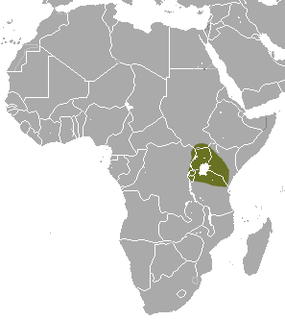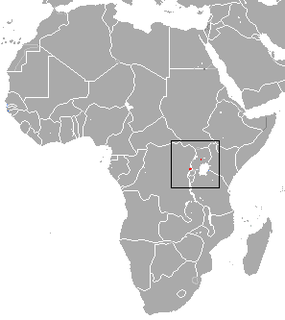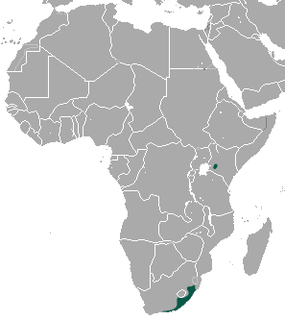Boulengerula uluguruensis, the Uluguru pink caecilian or Uluguru African caecilian, is a species of amphibian in the family Caeciliidae. It is endemic to Tanzania where it is found in the Nguu, Nguru, and Uluguru Mountains. Its natural habitats are subtropical or tropical moist lowland forests, subtropical or tropical moist montane forests, rural gardens, and heavily degraded former forest.
Nymphargus truebae is a species of frog in the family Centrolenidae, formerly placed in Cochranella. It is endemic to Peru. Its natural habitats are subtropical or tropical moist montane forests and rivers.

Eleutherodactylus martinicensis is a species of frog in the family Eleutherodactylidae found in Antigua and Barbuda, Dominica, Guadeloupe, Martinique, and Saint Lucia. Its natural habitats are subtropical or tropical dry forests, subtropical or tropical moist lowland forests, subtropical or tropical moist montane forests, subtropical or tropical moist shrubland, subtropical or tropical seasonally wet or flooded lowland grassland, arable land, pastureland, plantations, rural gardens, urban areas, and heavily degraded former forests. It is threatened by habitat loss.
Telmatobius truebae is a species of frog in the family Telmatobiidae. It is endemic to Peru. Its natural habitats are subtropical or tropical moist montane forest, rivers, and canals and ditches.
Ophryophryne microstoma is a species of frog in the family Megophryidae. It is found in Cambodia, China, Laos, Thailand, and Vietnam. Its natural habitats are subtropical or tropical moist lowland forests, subtropical or tropical moist montane forests, rivers, and swamps. It is threatened by habitat loss.

The long-snout torrent frog is a species of frogs in the family Ranidae.

Chirixalus nongkhorensis, commonly known as the Nongkhor Asian treefrog, Nongkhor pigmy tree frog and Nong Khor bushfrog, is a species of frog in the family Rhacophoridae. It is found in north-eastern India (Assam), Myanmar, Thailand, Cambodia, Laos, Vietnam, and Malaysia. Its natural habitats are subtropical or tropical moist lowland forest, subtropical or tropical moist montane forest, subtropical or tropical moist shrubland, intermittent freshwater marshes, and heavily degraded former forest. It is threatened by habitat loss.
Kurixalus odontotarsus is a species of frog in the family Rhacophoridae. It is found in southern China, Vietnam, Laos, and possibly Myanmar. Its natural habitats are subtropical or tropical moist lowland forests, subtropical or tropical moist montane forests, subtropical or tropical moist shrubland, intermittent freshwater marshes, heavily degraded former forest, and canals and ditches. It is threatened by habitat loss.
Kurixalus verrucosus is a species of frog in the family Rhacophoridae found in Myanmar, Thailand, China, and Vietnam. In the past, it has been considered synonym of Rhacophorus appendiculatus, which, together with other confusion regarding the identity of this species, makes interpreting older literature difficult. Its natural habitats are subtropical or tropical moist lowland forests, subtropical or tropical moist montane forests, rivers, and intermittent rivers. It is threatened by habitat loss.

The Bale shrew is a species of mammal in the family Soricidae.

Jackson's shrew is a species of mammal in the family Soricidae. It is found in Burundi, Democratic Republic of the Congo, Kenya, Rwanda, South Sudan, and Uganda. Its natural habitats are subtropical or tropical moist lowland forest, subtropical or tropical moist montane forest, and heavily degraded former forest.

The montane white-toothed shrew is a species of mammal in the family Soricidae. It is found in Kenya, South Sudan, Tanzania, and Uganda. Its natural habitats are subtropical or tropical moist montane forest and subtropical or tropical seasonally wet or flooded lowland grassland. It is threatened by habitat loss.

The small-footed shrew is a species of mammal in the family Soricidae. It is found in Angola, Burundi, Cameroon, Central African Republic, Chad, Democratic Republic of the Congo, Ethiopia, Kenya, Nigeria, Rwanda, South Sudan, Tanzania, Uganda, and Zambia. Its natural habitats are subtropical or tropical moist lowland forest, subtropical or tropical dry shrubland, and subtropical or tropical moist shrubland.

The Ugandan lowland shrew is a species of mammal in the family Soricidae. It is found in Kenya and Uganda. Its natural habitats are subtropical or tropical swamps and subtropical or tropical moist montane forest. It is threatened by habitat loss.

The tarella shrew is a species of mammal in the family Soricidae. It is found in Democratic Republic of the Congo and Uganda. Its natural habitats are subtropical or tropical moist lowland forest and subtropical or tropical moist montane forest. It is threatened by habitat loss.

The turbo shrew is a species of mammal in the family Soricidae. It is found in Angola, Burundi, Cameroon, Central African Republic, Republic of the Congo, Democratic Republic of the Congo, Equatorial Guinea, Gabon, Kenya, Malawi, Rwanda, South Sudan, Tanzania, Uganda, and Zambia. Its natural habitats are subtropical or tropical moist lowland forest and subtropical or tropical moist montane forest.

Zaphir's shrew is a species of mammal in the family Soricidae. It is found in Ethiopia and Kenya. Its natural habitats are subtropical or tropical dry forest and subtropical or tropical moist lowland forest.

The least dwarf shrew is a species of mammal in the family Soricidae. It is found in Cameroon, Central African Republic, Democratic Republic of the Congo, Kenya, Nigeria, South Africa, Eswatini, Tanzania, and Uganda. Its natural habitats are subtropical or tropical moist lowland forest, subtropical or tropical moist montane forest, temperate grassland, subtropical or tropical dry lowland grassland, subtropical or tropical high-altitude grassland, and arable land.

Johnston's forest shrew is a species of mammal in the family Soricidae found in Burundi, Cameroon, the Central African Republic, the Republic of the Congo, the Democratic Republic of the Congo, Equatorial Guinea, Gabon, Rwanda, Tanzania, and Uganda. Its natural habitats are subtropical or tropical moist lowland forest and subtropical or tropical moist montane forest. It is threatened by habitat loss.

The climbing shrew is a species of mammal in the family Soricidae, which is found in subtropical Africa. It is found in Angola, Benin, Burundi, Cameroon, Central African Republic, Republic of the Congo, Democratic Republic of the Congo, Ivory Coast, Ethiopia, Ghana, Guinea, Kenya, Liberia, Malawi, Mozambique, Nigeria, Rwanda, Sierra Leone, South Sudan, Tanzania, Togo, Uganda, Zambia, and Zimbabwe. Its natural habitats are subtropical or tropical moist lowland forest, subtropical or tropical moist montane forest, and moist savanna.














